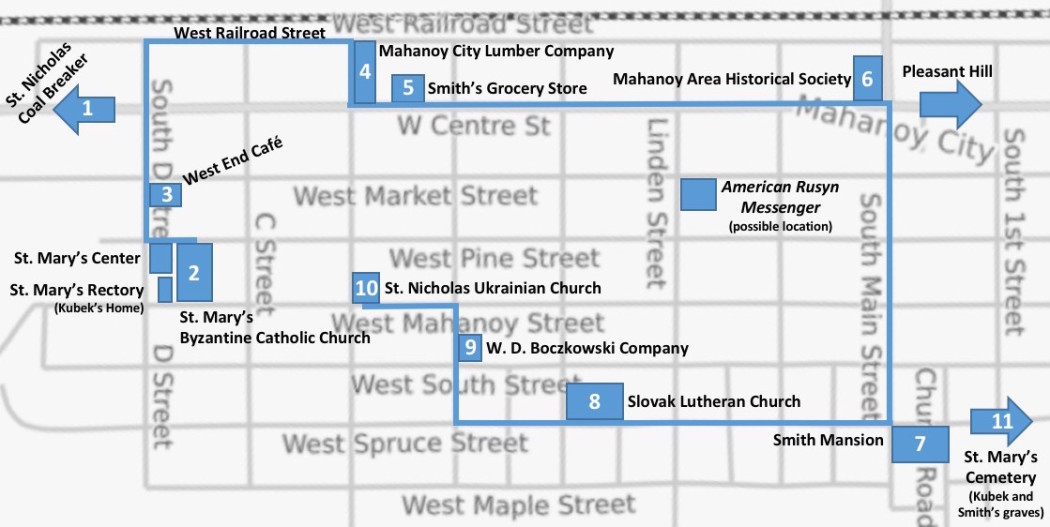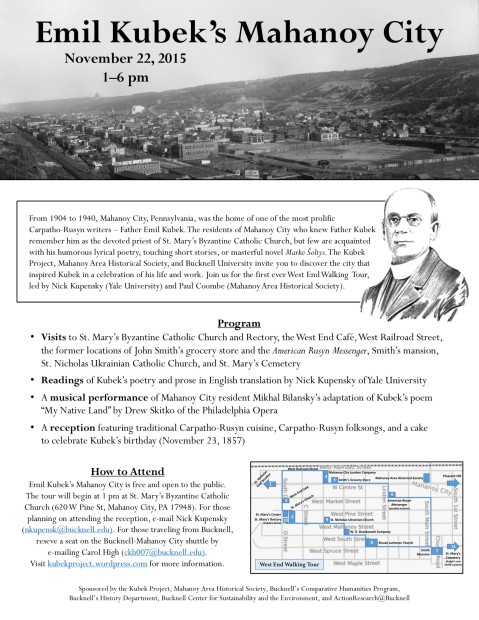
Emil Kubek Walking Tour
From 1904 to 1940, Mahanoy City, Pennsylvania was the home of one of the most prolific Carpatho-Rusyn writers – Father Emil Kubek. The residents of Mahanoy City who knew Father Kubek remember him as the devoted priest of St. Mary’s Byzantine Catholic Church at 621 West Mahanoy Street, but few are acquainted with his humorous lyrical poetry, touching short stories, or masterful novel Marko Šoltys, largely because Kubek’s work is written in Carpatho-Rusyn and the vast majority of it has yet to be translated into English.
In Europe, however, Kubek’s literary reputation has been growing over the course of the last 40 years. His prose and poetry play a central role in the literary course offerings in The Institute of Rusyn Language and Culture at the University of Prešov in Slovakia. Numerous monographs and articles have appeared on Kubek’s life and work. And an elementary school in Snakov, Slovakia — the village where Kubek served before emigrating to the United States — was named in his honor in 2008.
The Kubek Project aims to reestablish his role both as a significant Carpatho-Rusyn writer and an important voice within the American literary tradition. The first half of the twentieth century was the great age of the urban novel, and Kubek was the first Carpatho-Rusyn writer who attempted to make sense of the effects of urban mining life on Carpatho-Rusyn Americans. Kubek draws upon his experiences in Mahanoy City to create the settings of his short stories, incorporates many recognizable individuals, buildings, and neighborhoods into his prose, and expresses the challenges confronting Carpatho-Rusyn immigrants in his poetry. For this reason, the Emil Kubek Walking Tour invites you to discover this unique literary voice and the sights of historic Mahanoy City that inspired his work.
The tour includes:
1. The St. Nicholas Coal Breaker
Experience the ruins of the world’s largest coal breaker through Kubek’s “Lullaby of a Miner’s Child.”
2. St. Mary’s Byzantine Catholic Church
Be inspired by the church where Kubek lived and worked while reading Kubek’s farewell to the Carpathians “To My Homeland.” Then go inside and encounter Eastern rite religious art through Kubek’s ode to the “Three-Bar Cross!”
3. The West End Café
Take a shot in the oldest bar room in Mahanoy City over a recitation of Kubek’s “The Good Dad.”
4. West Railroad Street
Explore the Slavic neighborhood that inspired Kubek’s short story “An Easter Gift.”
5. Smith’s Market
Imagine the former site of John Žinčak Smith’s grocery store that serves as the setting for Kubek’s “Merry Christmas.”
6. The Mahanoy Area Historical Society
Chat with Paul Coombe and Peg Grigalonis about Mahanoy City’s history, and research their collection of texts by and about Kubek.
7. Smith’s Mansion
Marvel at the home of Mahanoy City’s wealthiest Carpatho-Rusyn, John Žinčak Smith, whose biography served as the foundation for Kubek’s protagonist “Palko Rostoka.”
8. Slovak Lutheran Church
Take a photo of the charming parish of Rev. Louis Sanjek, friend of Kubek and translator of his work, and read about his experiences as a Lutheran pastor to Mahanoy City’s Slovak community.
9. W. D. Boczkowski Company
Discover the history of Mahanoy City’s ethnic press at the former home of the Lithuanian newspaper Saule (The Sun), and read Kubek’s editorials published in The American Rusyn Messenger, a Rusyn-language newspaper founded in Mahanoy City and led by its influential editor, Paul Zatkovich.
10. St. Nicholas Ukrainian Greek Catholic Church
Learn about the evolution of ethnic identity in the Coal Region at the site of a defection from Kubek’s parish of Carpatho-Rusyns and Ukrainians from the Austrian province of Galicia.
11. St. Mary’s Cemetery
Celebrate the life of Emil Kubek by visiting his grave, and reflect upon what he valued most at the end of his life while reading a passage from his “Autobiography.”



